How to beat Goliath
Because size doesn’t matter
I have formulated 6 rules which I call David’s rules. These are for anyone facing the big one ...
“Dorai, we are all your children. May God bless you and keep you well, Dorai. Tomorrow I will show you the tea that you planted. Hundreds of people have a livelihood because of that tea. It is the rule in the estate that the pluckers take your name first before they start plucking that tea. It is called Baig Dorai Thotam (garden). Your name will never be forgotten as long as that tea remains, Dorai.”
I was in Lower Sheikalmudi Estate, in 2007, twenty years since I had been there last, as the Manager. Now I was visiting my old haunts, living my dream of enjoying the Anamallais without worrying about YPH (Yield per hectare) or tea prices. We arrived one evening and stayed in the Manager’s bungalow where we had lived, and which was now a guest house; of sorts. It still had the same curtains that we had installed twenty years ago, and you could tell. But nostalgia is a cure for many things and so we loved spending a couple of nights in our old home without worrying about how run down it looked.
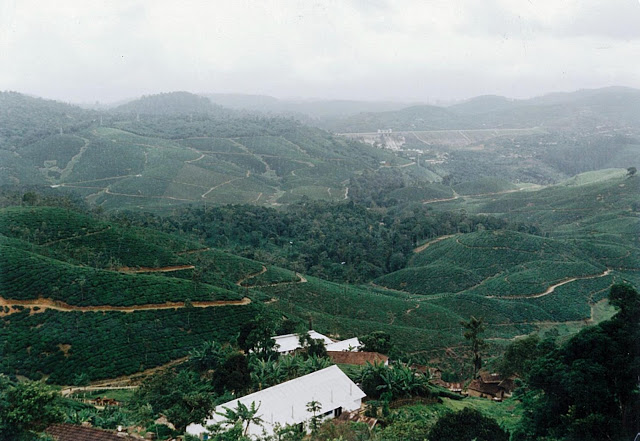
The next day we took a picnic lunch (flat masala omlettes, rolled in rotis with some pickle on the side) and walked up the hill to Manjaparai. Once we climbed down the hill from the bungalow, the climb is about four to five kilometers; never very steep but always rising. As you continue upwards, it can get quite taxing on a body used to sitting in chairs more than anything else. As you climb up out of the tea, you enter first the scrub jungle, very thick with all kinds of shrubbery including some very potent stinging nettles called Anaimarti. All my old memories came flooding back. My two friends, Raman & Raman, who worked on the estate and were my companions on my hikes and built hides for me to watch wildlife, were thrilled that I could still recognize the plants. Raman the younger cut a stout stick for me which is something that I used to like to keep as a climbing aid. Today I needed it more than simply wanting it. We walked through a path that Raman cut in the undergrowth with his pruning knife. As I walked, I remembered that this was the habitat of the Hamadryad or King Cobra (Ophiophagus hannah) which is an endangered species. Interestingly though it has ‘cobra’ in its name, it is not a cobra and is the only member of its genus. It is the longest poisonous snake in the world and can grow to as long as 18-19 feet. This snake preys on other snakes, is extremely fast but shy and so you are unlikely to see it unless you stumble on its nest. King cobras are the only species of snake to build nests for their young, which they guard ferociously. Nesting females may attack without provocation. When it is angry it rears up one third of its body which makes it as tall as a man and so the snake can actually look you in the eye. That can be terrifying to say the least. The Hamadryad has an enormous amount of venom, enough to kill twenty people or one elephant. But as I said, it is shy and so you hardly ever have any instances of people being bitten by them. The venom is neurotoxic and depending on the quantity injected into you, can kill in minutes.
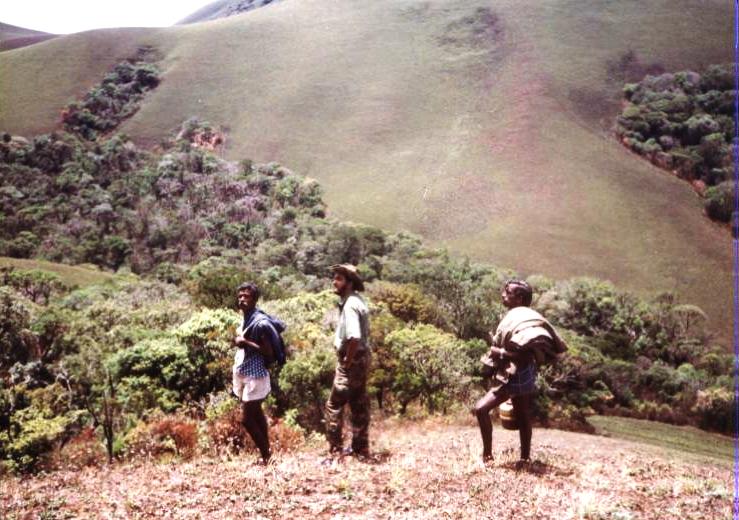
We came out of the brush eventually, having been bitten liberally by elephant ticks (the price to pay for climbing to Manjaparai) on to the base of the rock called Manjaparai (Yellow Rock) because of the color of a lichen that grows on this rock. There is a small stream that flows through a slight depression in it and at one point forms a shallow pool. This is the drinking pool that Sambhar and Gaur come to drink in. When we reached there that afternoon, we also found some old elephant dung strewn around the pool, but no fresh sign of any elephant. Walking up the hill, we surprised a basking cobra (Naga Naga) and then startled a Sambar doe that was resting in a thicket. She exploded out of the bush and galloped down a slope that was so steep that I would have hesitated to walk down it too fast. It was in the tree that grew out of the rock near the pool, that I’d had a platform (machan) constructed to watch animals from. I would pick a full-moon night with clear skies to sit in my machan. A clear night is much colder, but the full moon gives enough light to see without a torch. Nights on this platform were very cold but the sight of the sunset and its rising next morning was well worth the discomfort of the cold.
I would get up into the tree early so as not to disturb any game. One of the Ramans would sit up with me. The other one would see us to the place and leave and return early the following morning to collect us. It was not safe to stay on the ground during the night unless you had a fire. But the fire would drive all the game away and so we had this arrangement. Let me tell you about the sounds of the forest you would hear if you were to sit with me on the machan. The first call as the sun went down was always the jungle fowl going up to roost. First the cocks would crow – kak kaak, kaa kak?? – with a question mark at the end. Then the hens would sometimes cackle as they flew up to their roosts. There were no peacocks in the Anamallais in the 1980’s as it was too wet for them. But when I returned there in 2007, I saw peacocks. This shows that in the twenty years that I had been away, rainfall had reduced enough for peacocks to migrate up the mountain range from the plains and start living there. Not a good sign at all, the decline in rainfall. It will be interesting to check the meteorological data.
Once they settled in, the nightjars would start flitting on silent wings, catching nocturnal insects in flight as they came out of their hiding places. It is a fascinating sight to watch the nightjars as they took their interceptor flights. The nightjars sit in an open place (on a small rock or in the middle of the path) and make their characteristic call chut-chut-chut-churrrrrrrrrrrr. They repeat this call endlessly, sitting absolutely still but watching the world very closely. As soon as the nightjar sees a poor unsuspecting insect going about its business, it simply erupts into the air and the world insect population is reduced by one. 100% kill rate. Amazing birds.

Then there would be silence for a while as the jungle settled for the night. As the first light of the moon started to strengthen, a pair of Spotted Owlets would come out of their roosting places, where they had been hiding both from the sun as well as from the crows who harass them mercilessly if they see them in the open. They hunt in pairs. They fly out onto the flat branch that was their take off perch, one followed by the other. They would sit there for a while and talk to each other, perhaps discussing strategy. They are the most demonstrative birds that I have seen and to see them cuddling up to and nuzzling each other is extremely endearing. Then he would glide away in one direction and she in another. You must see an owl in flight to understand the meaning of grace. Suddenly you hear the dhank-dhank of the Sambar. This is the alarm call telling the other tenants of the jungle that one of the two big cats that live in this forest, the tiger and the leopard, is around. The Sambar is the most reliable of the sentinels and call only when they see these predators. Chital (none in these forests) also call and so do Barking Deer (plenty in the Anamallais). But both tend to be very skittish and will call on seeing many other things including shadows. Being on everyone’s dinner menu, does something to your perspective.
Another one whose alarm call must be taken seriously is the Langur; in this case the Nilgiri Langur and not the Grey Langur of the plains. They always have a sentinel watching from the highest perch that he can find, always on the lookout for big cats. But at night, the Langur are among the first to go to the treetops where they spend the night, safely out of harm’s way. Langur are at the top of the leopard’s dietary preference and so no wonder they prefer to be where the leopard is not subjected to any temptation. The Sambhar has fallen silent. This means that he can no longer see the tiger or leopard.

Then as you look at the deep shadows, one of the shadows moves and comes out into the open which is illuminated brightly by the moon. You can see the shine of the black coat and the white socks. You hear the snort as the bull clears his nose. The Gaur are here. As he gives the all-clear the cows and calves come out and all of them move to the shallow pool to drink. There is not enough water for all of them to drink together so they will remain there for as long as it takes for the pool to keep filling as they keep emptying it.
The presence of one herbivore is a sign to the others that the situation is safe. It is essential of course for us to keep silent, breathing softly and staying completely still. It is amazing how highly developed the senses of animals are, whose life literally depends on this. Make the slightest movement or sound and they vanish as if they had never been there. Raman seems carved in stone. I recall all my early childhood training in jungle craft and silently thank Uncle Rama and Nawab Nazir Yar Jung for teaching me to take care of myself and to reconstruct the story of the forest from the signs. Nobody could have had or wished for better teachers. Nawabsab spent many years in the Anamallais as a tea planter and he was my inspiration to join planting. A decision that I have always been very pleased about. Thanks to my decade long career as a planter, I learnt many valuable skills and life lessons and had the privilege of collecting some of the most beautiful memories and friends of my life. Raman and I sit in complete silence and watch the animals which are less than twenty meters away.
I had put out blocks of rock salt (salt licks) and some of the animals move away towards the salt lick and eventually even sit down to chew the cud around the salt lick. I have seen Sambar pick their way between resting gaur to get to the salt, all in perfect harmony with each other. As the night passes, we can hear elephants feeding in the forest bordering Manjaparai but that night they decide not to come out into the open. The night is now almost completely silent. All the grazing and hunting has been done. Now the whole world is resting. The time is 3 am according to the glow of my watch dial. The night is very, very cold. A breeze has started which blows unhindered up the slope of Manjaparai. The bison (gaur) herd has moved off back into the forest. There is nothing in sight. Raman and I are both shivering with our teeth chattering. We silently decide to descend onto the rock and light a fire. The firewood has already been collected the previous evening and is at the foot of the tree. We get down to the rock and Raman sets about creating a very nice and bright bonfire. To enjoy a fire truly one must first be at freezing point. Then you light the fire and sit in front of it and toast yourself. That is bliss.
Of course it destroys your night vision and if you have to suddenly turn and look into the darkness you are completely blind, but then in our case there is nothing to see in the darkness and so we both sit before the fire, wrapped in our blankets and talk of various matters grave enough to be spoken of at 3 am. It is amazing how people who we may dismiss as illiterate and uneducated (not that I ever did that), make observations, reflect upon them, and form educated opinions. A favorite topic with most Indians is politics and the antics of politicians. We are a very politically savvy people. We understand our politicians like nobody else. But what beats me is how we always manage to elect such puerile ones. Like the joke goes, ‘What happens when a politician drowns in the river?’ ‘It is called pollution.’ ‘What happens when they all drown?’ ‘It is called a solution.’
Raman and I would discuss the reasons for corruption in our system. Our people, the vast majority of them are good, simple, and have sincere hearts that have learned to become helpless. Every conversation ends with the same refrain, ‘Ah! But what can we do?’ The reality is that if anything can be done, it is only we who can do it. But this remains an elusive concept. Having put that to rest, we would watch the fire and simply sit in companionable silence, waiting for dawn. Raman proves that he is made of gold by pulling out a flask with piping hot tea and he and I share the tea and wait for the night to pass.
Gradually our talk runs out and we doze in spells. The fire starts to go down and every once in a while, either Raman or I put another log into it. Time passes. We see the owls that had left the previous evening, return to their perch and they have a long conversation recounting tales of the hunt. I have no idea whose story was more impressive, but both seem to have a lot to talk about. The sky is now starting to lighten. There is a strange blue light and I feel as if I am looking at the world from the bottom of the ocean. Then an orange tinge starts at the very bottom of the horizon and gradually grows upwards as if a fire has been started and is strengthening. And indeed, it has.
The final payoff of our trip is at hand. The sun is starting to rise. The sky catches fire. The flames rise higher. And then the top curve of the ball of fire appears on the horizon and rises rapidly upwards. The light is now strong. A new day has been born and I am fortunate enough to witness it. What price can I place on this privilege? All it took is a little discomfort of sitting half the night on the top of a tree. I thank Allahﷻ for showing me His creation.
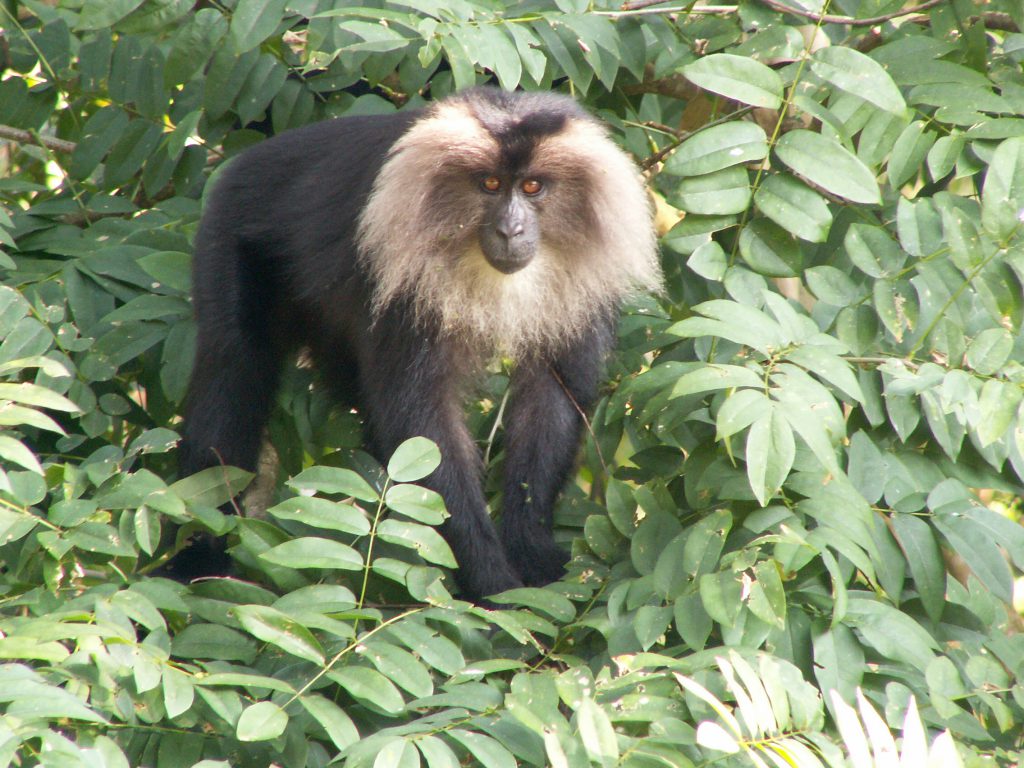
The new day starts with the Nilgiri Whistling Thrush (Whistling Schoolboy bird) and his liquid melody which he changes at will. We had a nesting pair in the Golden Showers creeper in our veranda. I used to whistle back, and he would respond. If I stopped, he would whistle and wait for me to reply. I have no idea what I was saying in his language, but whatever it was, he seemed to like it. I can’t describe the joy of beginning every day with that to start me off. On Manjaparai, I can hear the Yal-Tee-Yams (LTM – Lion-tailed Macaque – Macaca silenus) announcing that the new day is here. Then as the light strengthens, Jungle Fowl descend from the trees and the cocks call out their challenge; kak kaak, kaa kak?? – with a question mark at the end. You don’t normally hear the alarm calls of Sambar or Barking Deer at this time because the hunters have already hunted and are now resting after their meal. Langur call, just the communication calls.
You may hear the elephant herd, if you are downwind of them. First you will smell them. Then the squeal of the youngsters, feeling their oats early in the morning, usually butting each other and testing their strength while the matriarch leads them to the river to drink and bathe. As they walk, you can hear branches breaking as they feed, stomach rumbles, the low frequency call of the matriarch (you feel the vibration more than hear it) as she gives some instruction to her family. Even a trumpet occasionally. Just a honk of the horn. Not the scream of rage as an elephant thunders down on you at fifty miles an hour with the intention of wiping you off the face of the earth. That happenedto me once, a week after I joined as a brand-new Assistant Manager, but I managed to escape. The memory however is still fresh and lives with me. You can’t hear the hyper-low frequency calls which travel over a hundred miles, by which herds widely apart, communicate with one another. What do they say?
Then the wind shifts and their super sensitive sense, gets a whiff of you. Suddenly there is total silence. You hear nothing. No branches snapping, no squealing, no rumbles, no trumpeting. Not a dry twig will snap under a foot which has a sole like a truck tyre bearing a weight of four tons, but which can tread as softly as a feather when it wants to. If you could see them, you would see ears fanning for sounds, trunks raised, taking in sniffs of air and blowing them into the mouth to taste it. Their eyesight is not great but their hearing and smell more than makes up for that. Add to that a memory that is legendary and the fact that they are in familiar surroundings and know every patch of forest. Who knows what other senses they bring to bear to decide whether you present a threat or not? Before you realize it, the herd has gone, like the mist in the early morning. One minute they were there, and the next, there is only your memory of an encounter that will stay with you all your life.

As the daylight strengthens, birds come alive. They gather at their favorite trees to feed on berries, and on insects which get flushed by the berry eaters or to scratch in the dirt at the bottom of the tree for worms, beetles and caterpillars. Insects have a hard time in life, though they are so critical to everyone else’s survival. If you stand quietly and watch, you can see the tree divided into zones in which different species of birds operate. The most popular trees for birds, in this forest on the Western Ghats is the Banyan (Ficus Benghalensis), especially when it is in fruit. The tree itself is excellent nesting habitat for birds. Owls and Parakeets live in its hollows. Hornbills use those hollows to make their nests. Black Eagles, Changeable Hawk-eagles and other raptors make nests in the topmost branches. Imperial Pigeons, Green Pigeons, Ring-necked and other doves, crows, and many others, nest in the Banyan. This is a very productive tree to watch if you want to photograph birds. All this activity is accompanied by an absolute cacophony of sound with all the birds talking to one another at the top of their voices. No birdsong as such. This is feeding time and they are in a frenzy.

We often like to talk about the peace of the forest. That is a myth. The forest is a place of intense activity where to survive you need senses honed to perfection, total physical fitness, lightning reflexes and total awareness. The price of carelessness is hunger or death. And all this, every waking, living day and night of your life. No overweight animals in the forest and no pot bellies. The only exception are elephants, who thanks to their size and lifestyle of living together in family groups taking care of one another, can afford to relax. Life in the forest is all about survival. Whether you are a bird, reptile, mammal, amphibian or fish, it is all about survival. You must do one of two things and for some, you must do both; find food and prevent yourself from becoming food. Add to that finding mates, building nests, raising young and all the while protecting them and yourself from others who need to kill you to raise their own young and you have a very lethal and non-peaceful environment. But one in which you feel alive constantly. No time for depression, boredom or anxiety – all very human ailments.
To survive in the forest, you must be able to read it like you read a book. Observe signs, know what they mean and know what to do when you see them. Some you will see, some you hear, some you smell and to all you pay attention very carefully. You must know that you are also generating signs, most of the time unconsciously. And while you are not the natural food for anyone, you can get yourself into trouble if by your behavior you are seen as a threat, especially to the young of someone else. This is almost the only reason that people get injured, bitten or even killed in the forest. The solution is to learn woodcraft. If you know how to behave in a forest, you can be safe and enjoy yourself in one that is inhabited by all the potentially dangerous species you can think of. I am speaking of Indian and Sri Lankan forests. African forests are somewhat different in this respect. I have walked, camped, even slept in riverbeds in forests in India, inhabited by tigers, leopards, gaur, wild dogs, elephants and of course snakes and here I am writing about it all. That is because I learnt what to do and have a lot of respect for those whose territory, I am in.
African forests are different primarily because of lions. African lions are very different from Indian tigers and leopards and are addicted to junk food. I believe, so also are African leopards and Spotted Hyenas. So, sleeping in riverbeds in Africa is not what I would advise. I wouldn’t advise that in India or Sri Lanka either as a matter of course, but as I said, if you needed to, you could do that here. But in Africa, if you find yourself in such a situation, where there is a possibility of lions in the vicinity, find yourself a tall tree and climb it as far up as you can get. Think of yourself as a bag of potato chips or a bar of chocolate if you like. You get the message? Having said that, there are unfenced resorts in wildlife parks where you can camp and as long as you are inside your tent or in your car, you are safe. But if you need to go in the night, because when you gotta go you gotta go, it presents interesting possibilities. Not my idea of a holiday for sure.
To return to our story, it was as if I was watching a flashback movie. As I sat on the rock, eating my egg roll I remembered all these things as vividly as if I were watching it happen all over again. Twenty years had passed. The gaur I saw are all gone. So are the Langur. Their offspring have taken their place. Raman is there with me, but his hair is now jet black with hair dye. My beard is a salt-pepper shade with far more salt than pepper. There is change, but the rock is timeless. So is the forest. Ever changing of course, but strangely, still the same. Not often is one privileged to go back in time. I finished my meal and lay down on the rock close to the stream to sleep for a while. Raman & Raman moved away to either ends of the open space to take up watch positions. We are old friends and companions. Nothing needs to be said. Each knows what he should do. I can hear the small stream gurgling as I drift off into the best sleep that I have had in a very long time.
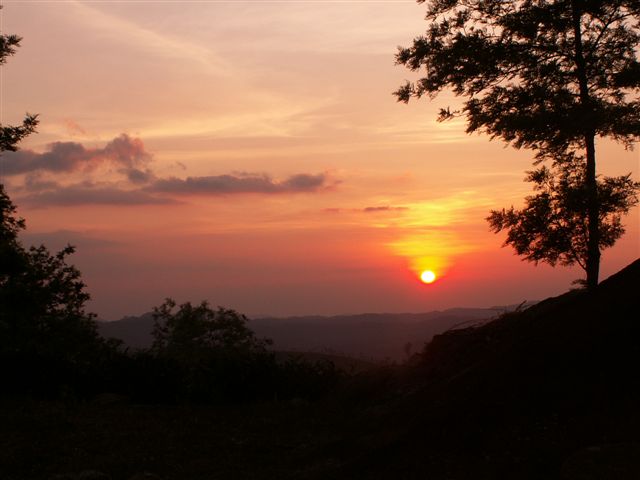
I woke up as the sun started its final journey to America. Only if it set here could the Americans have another day. So, we can’t delay it, can we? We gathered our things and started off back home, this time on a new track past the tea that I had planted 20 years ago. Today I was very eager to see what had become of it. Once again, we descended into the dark thickness of the undergrowth at the bottom of Manjaparai, now a little apprehensive as we can see fresh sign of elephant. We walk in single file with Raman in the lead and me at the rear with our friends who are new to this environment in the middle. We walk silently. Everyone has been given instructions about what to do if we come across elephants. But nothing as exciting as that happens and we emerge into what has become known as Baig Dorai Thotam (Baig Dorai’s Garden – the name that the pluckers gave it). I looked at it with tears in my eyes. It was the most beautiful sight that I had seen in a long time.
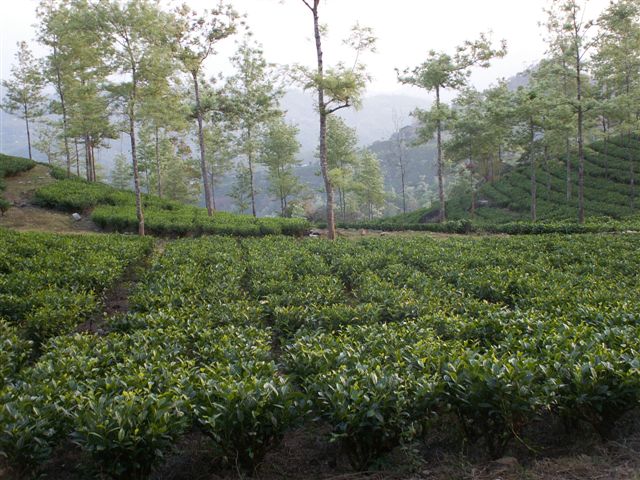
The tea has been extremely well looked after. They had done a height reduction prune to it and it is now back in plucking. Flat as a table, deep green maintenance foliage with light green plucking shoots standing proud and tall. Someone obviously has done an extremely fine job here. I was delighted that I had decided to come here and visit after so long.
We climbed up on another rock on the border of the tea overlooking the thick evergreen rain forest that the Anamallais are famous for. There is a single Spathodia in full bloom in the middle of the sea of green, the flame red color of the flowers standing out like a bonfire. I can see why it is called the Flame of the Forest. We sit in silence and watch the sun rise somewhere else. As the night descends, I thank Allahﷻ once again for giving me this opportunity to come back and see the result of my work and meet my old friends. I feel privileged and honored.
Please log in to leave a comment
Loading comments...
I have formulated 6 rules which I call David’s rules. These are for anyone facing the big one ...

One of my friends who comes from ...
I have said this a million times, if I have said it once – the three crimes committed on society with society’s blessing are: Commerci...